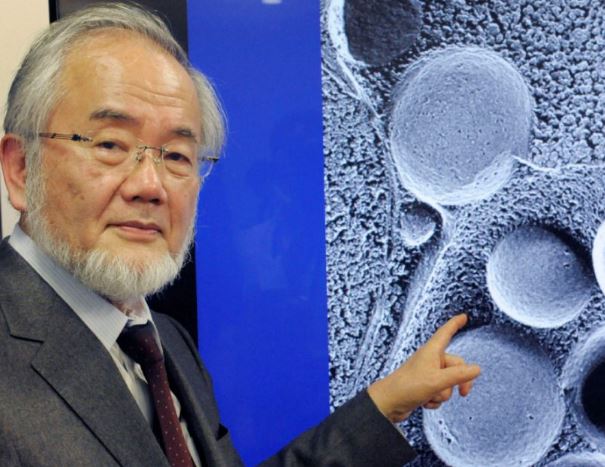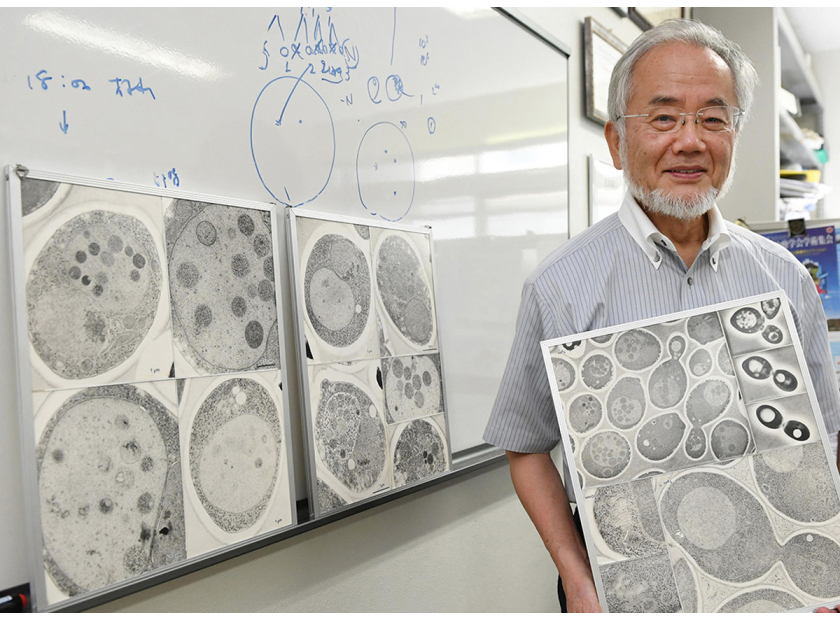Autophagy: Nature's Trash Recycling Service
Posted:
February 06, 2017
Did You Know You Are Autophagic? And that's a good thing, since it slows down aging and prevents degenerative diseases.
For illuminating the weird cellular phenomenon of "self-eating," Yoshinori Ohsumi has won the 2016 Nobel Prize in Physiology or Medicine. Called autophagy - from the Greek words "auto" and "phagein," meaning "self" and "to eat" - the process allows cells to destroy their own guts and essentially recycle them.

Autophagy is the natural, destructive mechanism that disassembles, through a regulated process, unnecessary or dysfunctional cellular components. It refers to the process in which cellular junk is captured and sealed in sack-like membranes, called autophagosomes. The sealed contents are transported to another structure called the lysosome, once considered little more than the cellular rubbish bin.

Our cells have various organelles and lysosomes constitute one such structure that contains enzymes for digestion of cellular contents. Recently a new type of vesicle called autophagosome was observed within the cell. As the autophagosome forms, it engulfs cellular contents, such as damaged proteins and organelles. Finally, it fuses with the lysosome, where the contents are degraded into smaller constituents (pictured above). This process provides the cell with nutrients and building blocks for renewal.
Little was known about the odd behavior until Dr. Ohsumi's brilliant experiments in the early 1990s. In these experiments, the Fukuoka, Japan-born scientist identified genes in yeast that were crucial to autophagy, revealing the underlying mechanisms of the process in yeast and showing that similar mechanisms were used in human cells.
One mystery that remained, however, was how the cell ditched and recycled larger protein complexes and wearied organelles. That's where Dr. Ohsumi's experiments came into play. By culturing mutated yeast that lacked enzymes used for degradation in the vacuole, while simultaneously starving the cells to trigger autophagy, Dr. Ohsumi was able to observe vacuoles filled with small vesicles that hadn't been degraded. He proved that autophagy occurs in yeast cells and went on to identify the genes involved in the process and how they come together to build the autophagosome membrane. The results showed that autophagy is controlled by a cascade of proteins and protein complexes, each regulating a distinct stage of autophagosome initiation and formation.
He later showed that a similar cellular recycling process occurs in human cells - and that our cells would not survive without it. The process is critical for cells to survive and to stay healthy.
Thanks to Dr. Ohsumi and others following in his footsteps, we now know that autophagy is a self-degradative process that is important for balancing sources of energy at critical times in development and in response to nutrient stress. Autophagy also plays a housekeeping role in removing damaged cell components such as clearing damaged mitochondria or misfolded proteins, as well as eliminating intracellular pathogens. During starvation, cells break down proteins and non-essential components and reuse them for energy. Autophagy is the body's internal recycling program - scrap cell components are captured and the useful parts are stripped out to generate energy or build new cells. It contributes to embryo development and cell differentiation. As well, the process is crucial for preventing cancerous growths, warding off infection and, by maintaining a healthy metabolism, it helps protect against conditions like diabetes and dementia. The failure of autophagy is thought to be one of the main reasons for the accumulation of cell damage and aging.
important for balancing sources of energy at critical times in development and in response to nutrient stress. Autophagy also plays a housekeeping role in removing damaged cell components such as clearing damaged mitochondria or misfolded proteins, as well as eliminating intracellular pathogens. During starvation, cells break down proteins and non-essential components and reuse them for energy. Autophagy is the body's internal recycling program - scrap cell components are captured and the useful parts are stripped out to generate energy or build new cells. It contributes to embryo development and cell differentiation. As well, the process is crucial for preventing cancerous growths, warding off infection and, by maintaining a healthy metabolism, it helps protect against conditions like diabetes and dementia. The failure of autophagy is thought to be one of the main reasons for the accumulation of cell damage and aging.
 important for balancing sources of energy at critical times in development and in response to nutrient stress. Autophagy also plays a housekeeping role in removing damaged cell components such as clearing damaged mitochondria or misfolded proteins, as well as eliminating intracellular pathogens. During starvation, cells break down proteins and non-essential components and reuse them for energy. Autophagy is the body's internal recycling program - scrap cell components are captured and the useful parts are stripped out to generate energy or build new cells. It contributes to embryo development and cell differentiation. As well, the process is crucial for preventing cancerous growths, warding off infection and, by maintaining a healthy metabolism, it helps protect against conditions like diabetes and dementia. The failure of autophagy is thought to be one of the main reasons for the accumulation of cell damage and aging.
important for balancing sources of energy at critical times in development and in response to nutrient stress. Autophagy also plays a housekeeping role in removing damaged cell components such as clearing damaged mitochondria or misfolded proteins, as well as eliminating intracellular pathogens. During starvation, cells break down proteins and non-essential components and reuse them for energy. Autophagy is the body's internal recycling program - scrap cell components are captured and the useful parts are stripped out to generate energy or build new cells. It contributes to embryo development and cell differentiation. As well, the process is crucial for preventing cancerous growths, warding off infection and, by maintaining a healthy metabolism, it helps protect against conditions like diabetes and dementia. The failure of autophagy is thought to be one of the main reasons for the accumulation of cell damage and aging.Disrupted autophagy has been linked to auto-immune disease, genetic diseases and neurodegenerative disorders such as Huntington's, Alzheimer's and Parkinson's disease, infectious diseases, heart disease, type 2 diabetes, cancer and a host of age-related disorders. Intense research is now ongoing to develop drugs that can target autophagy in various diseases. Thus, autophagy has emerged as a new and potent modulator of disease progression that is both scientifically intriguing and clinically relevant.
Dr. Ohsumi said he chose to focus on the cell's waste disposal system, an unfashionable subject at the time, because he wanted to work on something different. "I find it more enjoyable doing something nobody else is doing. In a way, that's what science is all about, the joy of finding something that inspires you." His discoveries have provided deep insights into the biology underpinning many diseases and are paving the way for new approaches to treating them.
By Corrie Landymore-Dodson, Hardy Diagnostics Technical Services
* * * * *
Nobel Prize winner. The Nobel Prize in Physiology or Medicine 2016. Nobel Prize.org. Karolinska Institutet. Retrieved 3 October 2016.
J. Pathol. 2010 May: 221 (1): 3-12.
Cuervo, A.M. et al. 2005. Autophagy and Aging: The Importance of Maintaining "Clean Cells". Autophagy. 1 (3): 131-140.
Comment(s)







